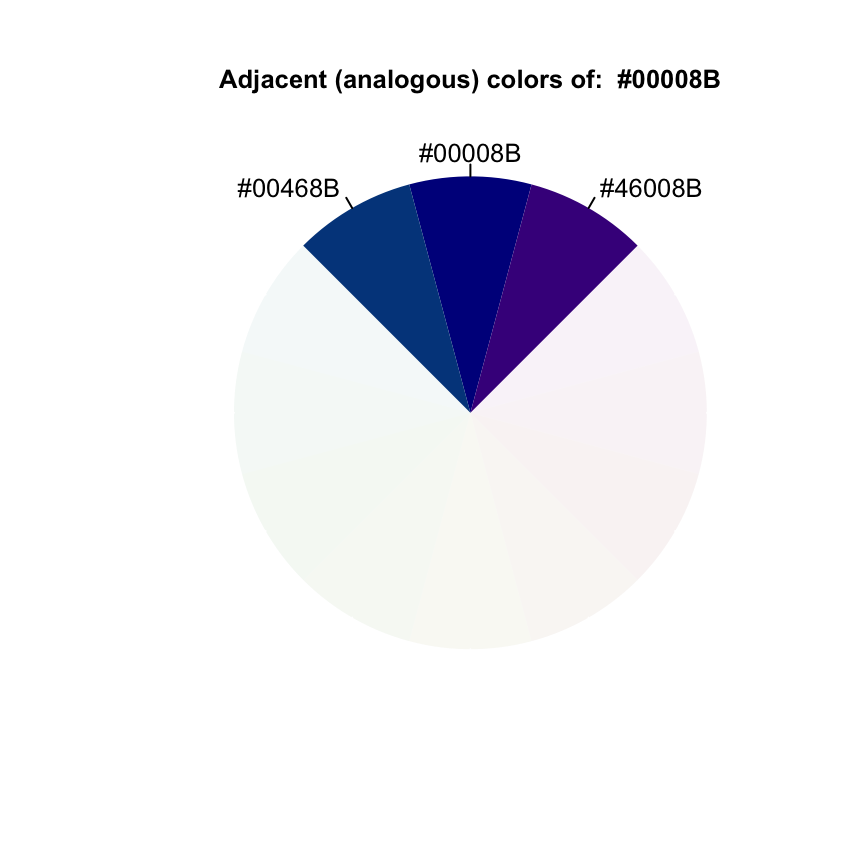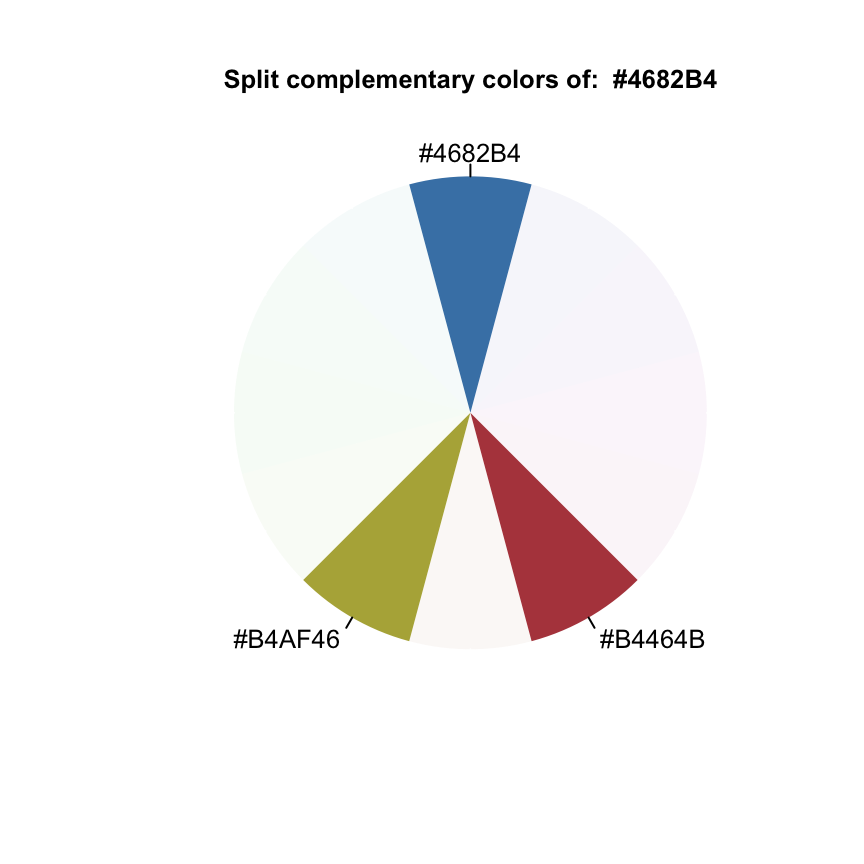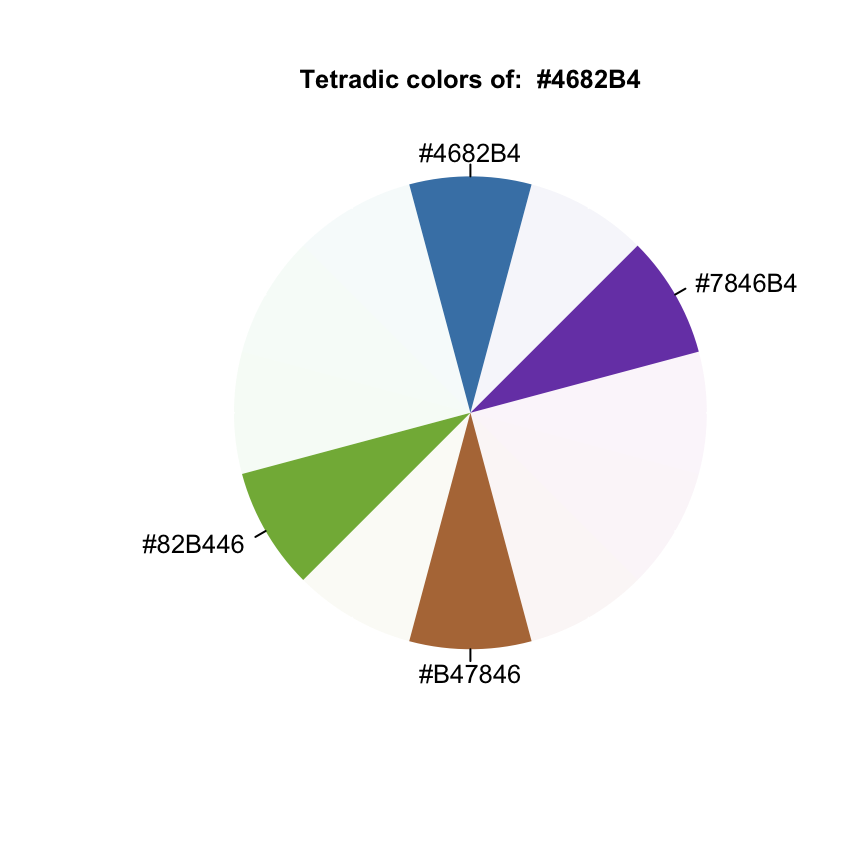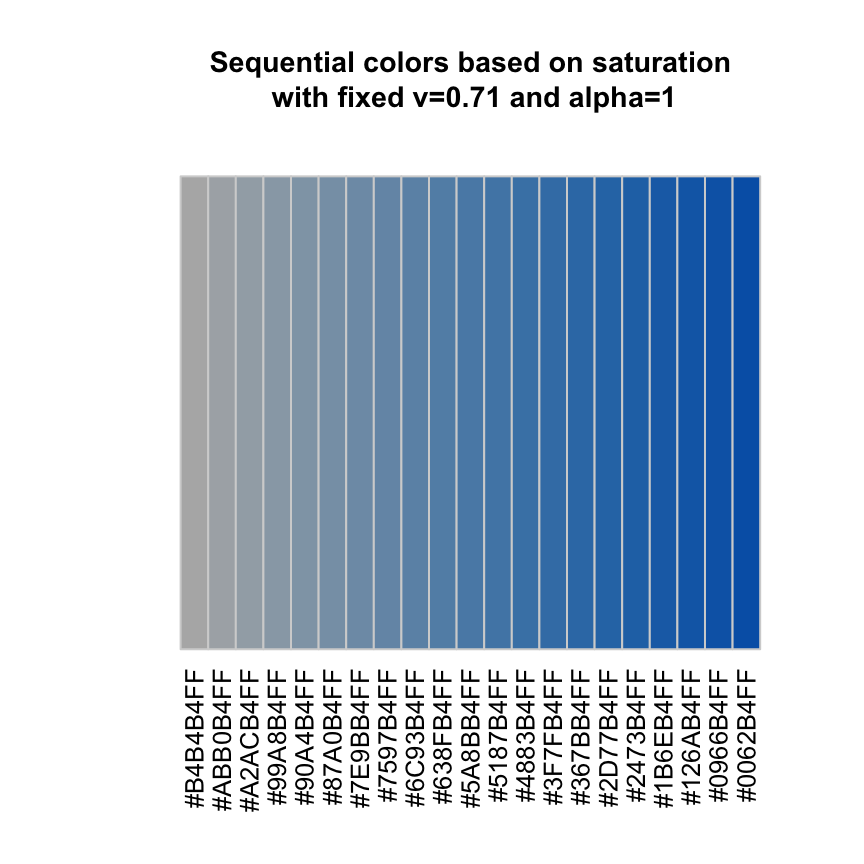The Elements of Choosing Colors for Great Data Visualization in R
Color is crucial for elegant data visualization. In our previous article we describe the list of color palettes available in R.
In this current article we define the basics for using the power of color and, we describe an R package and an online tool for generating beautiful color schemes.
Understanding color wheel

(Image from Nancy Duarte, slide:ology)
The color wheel helps you to visualize the relationships between colors.
The wheel is divided into pie slices which have the following components:
- hue (true color): On the wheel above, the hue is four rings out of the center.
- tints: correspond to the colors toward the center of the wheel (= hue + white color)
- shades: corresponds to the ring of colors on the outside of the hue ( = hue + black color)
Defining the basics for choosing colors
Monochromatic: Variations of the same color.
Analogous: colors that are touching in the wheel creates narrow harmonious color scheme.
Complementary: Colors from the opposite ends of the wheel provide the most contrast.

(Image from Nancy Duarte, slide:ology)
Split Complementary: A variation of the complementary scheme that uses two colors on either side of a directly complementary color. These colors have high visual contrast but with less visual tension than purely complementary colors.
Triadic: Three colors equally spaced around the color wheel create vivid visual interest.
Tetradic: Two pairs of complementary colors. This scheme is popular because it offers strong visual contrast while retaining harmony.

(Image from Nancy Duarte, slide:ology)
colortools: R package for creating easily color schemes in R
The excellent R package colortools developed by Gaston Sanchez is an easy to use solution for generating color schemes in R.
Install colortools
install.packages("colortools")Load colortools
library(colortools)Color wheel
The function wheel() can be used to generate a color wheel for a given color:
wheel("darkblue", num = 12)## [1] "#00008B" "#46008B" "#8B008B" "#8B0046" "#8B0000" "#8B4500" "#8B8B00"
## [8] "#468B00" "#008B00" "#008B45" "#008B8B" "#00468B"
Analogous color scheme
The function adjacent() or analogous() can be used:
analogous("darkblue")## [1] "#00008B" "#46008B" "#00468B"
Complementary color scheme
complementary("steelblue")## [1] "#4682B4" "#B47846"
Split Complementary Color Scheme
splitComp("steelblue")## [1] "#4682B4" "#B4464B" "#B4AF46"
Tetradic Color Scheme
tetradic("steelblue")## [1] "#4682B4" "#7846B4" "#B47846" "#82B446"
Square color scheme
square("steelblue")## [1] "#4682B4" "#AF46B4" "#B47846" "#4BB446"
Sequential colors
sequential("steelblue")## [1] "#B4B4B4FF" "#ABB0B4FF" "#A2ACB4FF" "#99A8B4FF" "#90A4B4FF"
## [6] "#87A0B4FF" "#7E9BB4FF" "#7597B4FF" "#6C93B4FF" "#638FB4FF"
## [11] "#5A8BB4FF" "#5187B4FF" "#4883B4FF" "#3F7FB4FF" "#367BB4FF"
## [16] "#2D77B4FF" "#2473B4FF" "#1B6EB4FF" "#126AB4FF" "#0966B4FF"
## [21] "#0062B4FF"
Read more
- slide:ology: The Art and Science of Creating Great Presentations (by Nancy Duarte)
- R package colortools by Gaston Sanchez.
Infos
This analysis has been performed using R software (ver. 3.2.3) and colortools (ver. 0.1.5)
Show me some love with the like buttons below... Thank you and please don't forget to share and comment below!!
Montrez-moi un peu d'amour avec les like ci-dessous ... Merci et n'oubliez pas, s'il vous plaît, de partager et de commenter ci-dessous!
Recommended for You!
Recommended for you
This section contains the best data science and self-development resources to help you on your path.
Books - Data Science
Our Books
- Practical Guide to Cluster Analysis in R by A. Kassambara (Datanovia)
- Practical Guide To Principal Component Methods in R by A. Kassambara (Datanovia)
- Machine Learning Essentials: Practical Guide in R by A. Kassambara (Datanovia)
- R Graphics Essentials for Great Data Visualization by A. Kassambara (Datanovia)
- GGPlot2 Essentials for Great Data Visualization in R by A. Kassambara (Datanovia)
- Network Analysis and Visualization in R by A. Kassambara (Datanovia)
- Practical Statistics in R for Comparing Groups: Numerical Variables by A. Kassambara (Datanovia)
- Inter-Rater Reliability Essentials: Practical Guide in R by A. Kassambara (Datanovia)
Others
- R for Data Science: Import, Tidy, Transform, Visualize, and Model Data by Hadley Wickham & Garrett Grolemund
- Hands-On Machine Learning with Scikit-Learn, Keras, and TensorFlow: Concepts, Tools, and Techniques to Build Intelligent Systems by Aurelien Géron
- Practical Statistics for Data Scientists: 50 Essential Concepts by Peter Bruce & Andrew Bruce
- Hands-On Programming with R: Write Your Own Functions And Simulations by Garrett Grolemund & Hadley Wickham
- An Introduction to Statistical Learning: with Applications in R by Gareth James et al.
- Deep Learning with R by François Chollet & J.J. Allaire
- Deep Learning with Python by François Chollet
Click to follow us on Facebook :
Comment this article by clicking on "Discussion" button (top-right position of this page)








